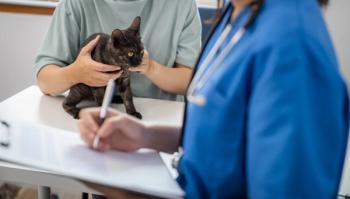
Evaluating normal neonates (Proceedings)
The neonatal development can be divide into specific time periods; the neonatal period (birth - 2 weeks); the transitional period (2-4 weeks); the socialization period (4 -12 weeks), and the juvenile period (12 weeks - puberty).
The neonatal development can be divide into specific time periods; the neonatal period (birth - 2 weeks); the transitional period (2-4 weeks); the socialization period (4 -12 weeks), and the juvenile period (12 weeks - puberty). During the late socialization period and juvenile period, most puppies and kittens are growing versions of the adult.
The goal of neonatal care is to maximize the health and well being of the newborn puppy and kitten. The canine and feline neonates differ from the adult counterpart in numerous ways. Determining the normal from an abnormal physical, physiological and/or diagnostic findings is essential in enhancing the survival of the sick or marginal youngster. I always recommend the mother and entire litter be examined. Occasionally a "house call" is in order to decrease the stress, environmental impact, and infectious diseases exposure than can occur with a routine hospital visit. Clinical evaluation of puppies and kittens starts with a complete case history. Information including breed, age in days, and parturition history plus the owner's concerns are essential to the case management. After obtaining the history a comprehensive physical examination should be conducted on a warmed surface. I perform the Physical examination in the same order as on the adult with a couple of exceptions.
General condition: A physical examination starts with observing the animal's body general condition, body movements, mentation, posture, locomotion, and breathing patterns before handling the neonate.
Birth weight: Weigh the neonate on a warm gram scale. Birth weight is the single most important predictor of neonatal survival. Toy breeds 100 – 200 g, Large breeds 400 – 500 g, and Giant breeds 700 g. Healthy kittens should weigh 100 g +/- 10 g. Low birth weights are associated with poor performance, morbidity, mortality and congenital defects. As small birth weight puppies and kittens are often physiologically dysmature, those neonates that are < 25% of the litter average weight, are at high risk for hypoglycemia, hypothermia, hypoxia, bacterial septicemia and pneumonia. A deficiency in some growth factor, an endocrinopathy, poor maternal nutrition, small placental size (uterine crowding), and inheritable and congenital anomalies have all been incriminated causes for the lowered birth weights. Even if these "runts" make it through the critical first 2 week period, they may be chronic "poor doers" and may still die at a young age. Close observation and careful monitoring are paramount to their survival chances. Surprisingly some of these small fries actually catch up to their littermates.
Monitoring weight gain is a good indicator of health status. Reported criteria for adequate weight gain have been reported during the neonatal period include; nursing puppies should double their weight in 10 days; the puppies should gain 5-10%/day; and puppies should gain 2 g/kg of the expected adult weight/day. Nursing kittens should also double their weight in 10 days; normal kittens gain 10 - 15 g/day; and the kittens should weigh 1 pound/month for the first 4 months. Formula fed neonates grow at significantly slower rate despite the identical caloric intake doubling their weight in 14 days.
Thermoregulation: An accurate rectal temperature in neonates requires a digital thermometer that reads to 95°F. Thermoregulation is problematic in the neonate. The shivering reflex and peripheral vasoconstriction response are not fully developed until at least 1 week. Their relatively large body surface area of non-cornified skin, plus the lack of insulating fat, promotes rapid heat loss by conduction, convection, radiation, and evaporation. The vulnerable young must relay on the ambient temperature, the dam's mothering instincts, and littermates for warmth. Environmental temperature exposure can be critical as a healthy newborn can only maintain a body temperature 12° > than that of the surrounding environment.
Normal body temperature........................Recommended temperature if
of the newborn........................................orphaned or hospitalized
Week 1: 96°- 98°....................................85-90°
Week 2: 99°............................................80°
Week 3: 100.5°.......................................80°
Week 4: normal stable temperature...........80°
Week 5: normal stable temperature...........70°
Hydration assessment: Dehydration is always a concern with a sick puppy or kitten. It is no surprise they are extremely susceptible to dehydration. Neonates are 75% water with a disproportionately large body surface area is covered with non-cornified skin combined with an inability to concentrate their urine. Water turn over is 2-3X that of an adult. Unlike an adult, hydration status can not be accurately assessed using skin turgor. Estimates of the degree of dehydration must be determined by dryness of the oral mucus membranes and eyes, plus the urine specific gravity.
Skin: The skin should be checked for wounds and bruising. Spare or absence of hair on the dorsal feet is usually indicative of prematurity.
Head: Examine the skull for shape and for an open fontanelle. Many toy breeds are born with a palpable open fontanelle and a small opening may be normal in the Persian. Most openings should be closed by 9-12 weeks although in is not uncommon for the opening to persist in certain breeds (Chihuahuas, Miniature Dachshunds) without obvious consequence.
Oral cavity: The oral cavity should be inspected for evidence of a cleft palate. The oral mucous membranes including the tongue should be light pink and moist. During nursing or crying the tongue becomes hyperemic. Oral ulcerations may indicate sepsis or viremia.
The teeth, if present, should be evaluated for early occlusion problems. Both puppies and kittens are born with "overshot" maxillas (brachygnathism) that allows them to better nurse. As the puppy or kitten nears weaning age, the mandible goes through a rapid growth spurt to regain the normal position. If the growth spurt is delayed, then the deciduous mandibular canines will erupt behind the maxillary canines creating a "permanent" malocclusion situation.
Normal loss of maxillary deciduous teeth occurs at 14 weeks with complete permanent replacement by 6 months
Gastrointestinal system: The gastrointestinal tract is sterile at birth but is rapidly colonized by variety of bacterium including; E. coli, Proteus, Enterococcus, Lactobacillus, Clostridium and Bacteroides from the mother. The soft, yellow brown meconium is passed within the first 48 hours. Then the normal neonatal feces are pasty yellowish tan but usually not observed with a fastidious bitch or queen. The stools should become formed at weaning. Overfeeding produces a green or yellow watery stool; and white stools are observed with intestinal lactase and galactase deficiencies. Foamy bright yellow stools may be present with Canine Herpes Virus. Blood tinged stools may be seen in sepsis or with coccidiosis. Decreased hepatic function, for the first 4 weeks, is related to the underdeveloped liver enzyme systems, cytochrome 450, demethylation, reduction, and hydroxylation. This is reflected in abnormal bile acids and caution should used in selection of drugs metabolized and/or excreted via the liver. ALP is elevated in neonates as in the juvenile patients but the ALT should be within the normal range. A fasting puppy can maintain an adequate blood glucose for 24 hours initially through glycogenolysis then gluconeogenesis. After that period a precipitous drop occurs.
Renal system: While the numbers of functional nephrons are present at birth, nephrogenesis, as measured by a GFR and the inability to concentrate urine is incomplete until at least 3 weeks of age. The BUN will be on the high end of normal for 7 days then declines to the low end of the adult normal. Sufficient urine for a partial urinalysis can easily be collected by the anogenital reflex. The normal Specific Gravity ranges from 1.006 -1.017 and is used to estimate hydration status and response to fluid therapy. Mild glucosuria and proteinuria is considered normal for up to 6 weeks.
Genitals: Determining a kitten's sex can be difficult and embarrassing especially if a single kitten is presented. Male kitten's perineal region look like a colon: and the female's appears as a semi-colon; the average kitten's urogentital distance at birth is 12.9 mm in females and 7.6 mm in males. At three weeks of age the distance increases to 17.8 mm and 10.0 respectively.
Gonads should be descended at birth although "normal" variations exist. Most puppies will have descended testis by 4 - 7 weeks of age. However I would not diagnosis cryptorchidism until 14 weeks.
Umbilicus: The umbilical cord should be visualized checking for evidence of infection/inflammation and should dry up and fall off by day 3. The adjacent abdominal wall should be palpated for umbilical or inguinal hernias. An umbilical infection is a common source for septicemia.
Cardiovascular system: Cardiovascular physiology of the neonate varies significantly form the adult. Neonates have a lower blood pressure, stroke volume but a faster heart rate, greater cardiac output and central venous pressure. The heart rate in the neonatal pup is 200 b/minute and the kitten averages 250 b/minute. The rhythm is a regular sinus unaffected by breathing. This elevated heart rate decreases as the puppy/kitten develops increased parasympathetic influences (vagal tone) at 4 weeks of age. Atropine, isoproterenol, and dopamine have minimal effect on cardiac function until 4-5 weeks of age. Successful neonatal cardiac auscultation requires considerable skill, a quite room and a pediatric stethoscope. Two categories of murmurs may be heard. Serious heart murmurs associated with a congenital cardiac defects are usually loud (grade >II/VI) often with a precordial thrill, occur at any timing, and persists beyond 12 weeks. Functional/innocent/physiologic murmurs are soft (grade > III/VI) early systolic, are heard best at the left base, change with position, and do not persist past 12 weeks. These murmurs are usually idiopathic but can be associated with increased blood velocity associated with stress, fever, sepsis, anemia or hypoproteinemia.
Respiratory system: At birth the respiratory rate is normally 15/min, but rapidly reaches the normal 30/minute within 1-3 hours. Because of the small tidal volume, assessment of lung sounds is difficult. Always examine for stenotic nares. Taping a newborn to an inclined board helps stimulate the breathing and airway fluid drainage.
Nervous: Central nervous system development is slow in the neonate. They sleep at least 90% of the time. Until 4 weeks of age, the majority of the sleep is the deep, activated type sleep. Activated sleep tones and strengthens those muscles necessary to allow the neonate to stand at 10 days (kitten) and 14 days (puppy) then walk by day 21. Active learning begins at 3 weeks and the important primary socialization period is weeks 4 - 8. Reflexes can be difficult to assess in the neonate because of variations in development and the technical difficulty associated with size. Puppies and kittens are born with a righting, withdrawal, and tactile anal and urinary reflexes. From birth to day 3 they demonstrate total flexor dominance but by day 4 extensor dominance is predominate until 3 weeks. The suckling reflex is present until 3 weeks of age. The rooting reflex is present at birth. Cross extensor reflexes may be normally present at birth but should not be present after 14 days. Crossed extensor reflux after this time period is indicative of upper motor neuron pathology. Neonates can not voluntarily urination or defecate. These functions are initially controlled by an anogenital reflex associated with vigorous stimulation of the perineal area with the mothers tongue or a wet swab. Although this reflex is present for up to 28 days in puppies and 40 days in kittens, the stimulation is only requires for the first 18-21 days.
Eyes: Generally the eyelids open at 10 -14 days revealing a cloudy cornea which clears within 24 hours. For the first 3 weeks vision is poor. The corneal reflex is present as soon as the eyes open however the menace reflex is poor to absent for the first 3 weeks. Although the pupilary light reflexes are present within 24 hours of the lid separation, they are difficult to evaluate until about 21 days of age. Reflex lacrimation begins when the eyelids open. The true iris color is complete by week 8.
Ears: While the puppy can hear at birth, the external ear canals do not open until 10-14 days at which time the startle response begins. The brain stem auditory response (BAER) is the best method of evaluating a puppy or kitten's hearing. Routine testing of specific breeds (i.e. Dalmatians) should not be done before 6 weeks of age.
Maternal Immunity: 95% of the neonate's passive maternal immunity is derived from the colostrum within the first 24 hours of nursing.
Diagnostic sampling: To decrease the chance of hemolysis blood samples should be collected by jugular venipuncture using a 22-25 gauge needle attached to a 3 ml syringe. Do not use alcohol because of its cooling effect on the neonate. A 100 Gm kitten has about 6 ml of blood so draw no more than 0.5 ml for the first few days of life.
Hematology: A considerable variation in the post partum red mass exists between various breeds and even littermates. Generally speaking the neonate has a high red cell mass (MCV and PCV) at birth however both gradually decline until 8 weeks then slowly returns to an adult level by week 20. This is related to replacement with "adult" red cells and increase ECF volume associated with growth. The puppy reticulocyte count is similar to an adult's. During this period, the youngster is particularly susceptible to parasitic blood loss. Conversely, the right shift in the oxygen disassociation curve allows more effective oxygen transport despite the lowered PCV. The "average" PCV changes are PCV at birth 42%, by week 3 30%, by week 4 26%, by week 8 24%, by week 9 ↑ to normal by week 20.
The normal neonate has a WBC count and differential similar to an adult high normal; however they have a poor marrow reserve. Sepsis creates a rapid neutropenia.
Serum chemistries: Adequate laboratory data can be assessed using micro-capillary techniques or reagent strips. The BUN will be on the high end of normal for 7 days then declines to the low end of the adult normal. ALP is elevated in neonates as in the juvenile patients. ALT should be in the normal range. The phosphorous will also be elevated. Electrolytes will be in the normal range.
Urinalysis: Sufficient urine for a urinalysis (chem strip, specific gravity, and sediment) can easily be collected by the anogenital reflex.
Imaging: Radiographic interpretation is much more difficult because of size, lack of abdominal fat and poor mineralization of the bones. It is diagnostic for bloat, ileus, severe pneumonia, aspiration pneumonia, and cardiac enlargement. Reducing the KVP to ½ the adult and using detailed film/screens ill improve image quality. Depending on the fontanelle opening, a ventricular ultrasound can also be a useful tool for the diagnosis of congenital hydrocephalus.
Electrocardiogram: Lead II electrocardiograms can be used to diagnose arrhythmias and conduction disturbances in kittens and puppies
Neonates are not "little" adults and the obvious differences must be addressed in the diagnosis and management of neonatal problems.
Newsletter
From exam room tips to practice management insights, get trusted veterinary news delivered straight to your inbox—subscribe to dvm360.




